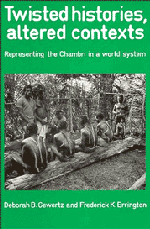Book contents
- Frontmatter
- Contents
- List of illustrations
- Acknowledgements
- Introduction: On writing the Chambri
- 1 The new traditionalism: tourism and its transformations
- 2 The initiation: making men in 1987
- 3 The town
- 4 Western representations at home
- 5 The written word
- 6 Negotiating with the state
- Conclusion: Interlocking stories, intersecting lives
- Appendix A: Godfried Kolly's life story
- Notes
- References
- Index
4 - Western representations at home
Published online by Cambridge University Press: 05 June 2012
- Frontmatter
- Contents
- List of illustrations
- Acknowledgements
- Introduction: On writing the Chambri
- 1 The new traditionalism: tourism and its transformations
- 2 The initiation: making men in 1987
- 3 The town
- 4 Western representations at home
- 5 The written word
- 6 Negotiating with the state
- Conclusion: Interlocking stories, intersecting lives
- Appendix A: Godfried Kolly's life story
- Notes
- References
- Index
Summary
None of those Chambri living in Wewak and beyond whom we have described was free from the pull of the society that provided each with elements crucial for personal definition. John Illumbui acknowledged explicitly the strength of the pull; Martin, despite his efforts to cultivate a subjectivistic individualism, never could entirely deny it. They were, as were virtually all Chambri, inextricably involved in twisted histories, in recursive relations of entailment, that tied them to those living and dead at Chambri Island. That the links of entailment led back to Chambri Island was not, however, just because until rather recently all Chambri had lived there. It was also because the ancestors from whom Chambri derived major aspects of their personal identity were literally grounded at Chambri. As “The Story of the Founding of the Walindimi Men's House” has already demonstrated with respect to Maliwan and his long-dead predecessor, Yerenowi, Chambri viewed their relationships and powers in terms of, and as stemming from, those of their ancestors.
Hence, it was only with other Chambri that the entwined relationships that located and constituted the self could be satisfactorily enacted and it was at Chambri that the social relationships of entailment originated and had the greatest density. Furthermore, only at Chambri itself could the relations with the ancestors and their powers be established. (Individuals away from Chambri relied on relatives at home to mobilize ancestral support for them.)
- Type
- Chapter
- Information
- Twisted Histories, Altered ContextsRepresenting the Chambri in the World System, pp. 126 - 146Publisher: Cambridge University PressPrint publication year: 1991



